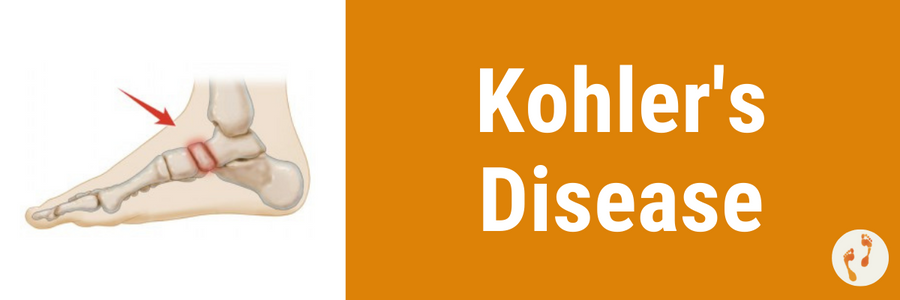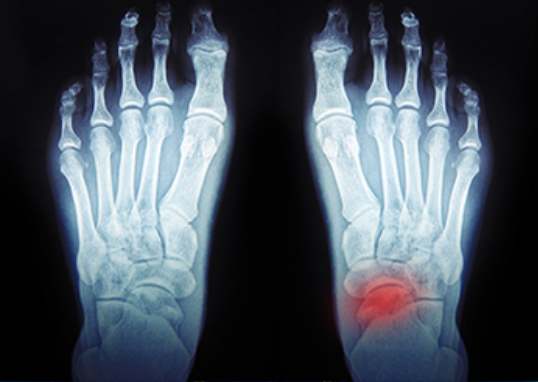 Kohler’s disease (avascular necrosis) is an often misdiagnosed cause of pain just in front of the ankle where a lack of blood supply to a specific area may cause the bone tissue to die over time. An accurate and timely diagnosis is crucial to help get the best outcomes for your foot.
Kohler’s disease (avascular necrosis) is an often misdiagnosed cause of pain just in front of the ankle where a lack of blood supply to a specific area may cause the bone tissue to die over time. An accurate and timely diagnosis is crucial to help get the best outcomes for your foot.
Kohler disease is specific to a bone called the navicular, which sits just in front of the ankle on the inside border of your foot. This condition is a type of avascular necrosis, meaning that an interrupted or reduced blood supply to the bone means that the bone cells cannot maintain healthy and optimal function, which may lead to bone tissue death, tiny cracks in the bone, and ultimately bone collapse. This is a gradual process, often taking months to years to occur – hence often having a significant window of opportunity to detect and diagnose the problem and get the right, timely treatment.
We see Kohler disease most often in children between the ages of 3-9 years old, though it can occur across the entire age range. It usually affects just one foot and is seen in boys more than girls by up to five times.
Symptoms we see in someone with Kohler’s disease may include:
 Foot pain and swelling
Foot pain and swelling- Redness or warmth in the area
- Pain radiates along the arch, as well as being present at the front of the ankle at the affected bone
- Difficult to put weight on the foot – often limping is seen
As the symptoms of Kohler’s disease begin as mild and stay this way for a while, many people will wait before seeking care, thinking it is a regular injury that will go away on its own.
The exact cause of Kohler’s disease is unclear in the research. It is theorised that it may be linked to:
- Injury, compression or excess stress on the navicular bone during growth
- Delayed bone formation
- Genetic factors
- Abnormalities of the navicular bone
Can You Fix It?
We would expect the symptoms of Kohler disease to resolve within a year. Unfortunately, until this time, putting weight on the foot, walking and completing everyday activities may be difficult and painful. This is where our podiatrists can help to significantly improve your comfort during this time.
Kohler Disease Treatment
The goal of any treatment is to help you manage your symptoms and monitor your progress so we can detect any abnormalities or concurrent conditions early. After the condition resolves, we do not expect that you’ll have any longstanding damage or changes, and the size, density and structure of your navicular should be restored. To help, we may use:
- Custom foot orthotics: we may prescribe a custom pair of orthotics using a 3D foot scan paired with a comprehensive assessment to help offload the navicular and painful area, while adding cushioning from greater comfort, and keeping your foot and arch well supported according to your unique foot characteristics and needs
- Footwear: while we don’t sell any shoes, our podiatrists can recommend the best shoes for your specific foot type to help offer you the best support and comfort. These shoes will also work as a team with your orthotics to help reduce your pain and improve your mobility and comfort. We can also make modifications to your existing footwear to help.
- Boot or brace immobilisation: in some severe cases, it may be best to offload and immobilise your foot and ankle. We have a range of options available to achieve this.
- NSAIDs: under advice from your doctor, non-steroidal anti-inflammatory medication may be used to help reduce pain.
Surgery is not indicated in the management of Kohler’s disease.
FAQs
Who is most likely to get Kohler’s disease?
Often, Kohler’s disease affects children between the ages of 3 and 7, although it can occur up to age 10. Boys are affected more often than girls, and it is more common in children of African and Hispanic descent. Children who are physically active, especially those involved in activities that put repeated stress on the foot, such as running or jumping, may be at a higher risk for developing Kohler’s disease. Other risk factors may include obesity and a family history of foot problems.
How long does it take to recover from Kohler’s disease?
The recovery time for Kohler’s disease can vary depending on the severity of the condition and the age of the child. In general, mild cases may resolve on their own within several months to a year, while more severe cases may take longer to heal.
Can Kohler’s disease cause long-term complications?
In most cases, Kohler’s disease does not cause any long-term complications but can cause notable pain and discomfort while it is present.
